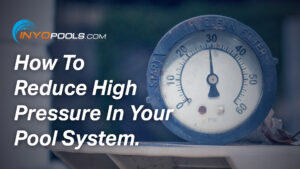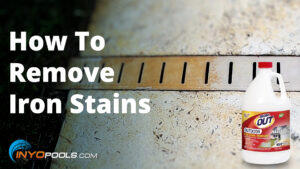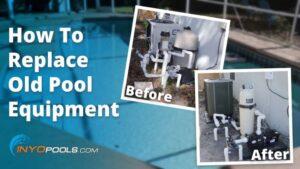High pressure in swimming pools is something we hear about quite frequently. We get tons of phone calls, emails, chats, and even questions on our new INYO Pool Forum specifically on how to reduce high pressure in your pool system. There are several high-pressure scenarios that can arise on any day for a number of reasons. Each pool setup is different and therefore variables play a role in determining the root cause. Still, reducing high pressure is a common occurrence that can frequently happen if you’re not careful. In this blog post, we address what high pressure means to your system, the different ways in which pressure can build, and ultimately how to reduce the high pressure in your pool system. Hopefully, our blog is your one-stop-shop for all of your issues related to high pressure.
What Is High Pressure?
When pool owners claim they have high pressure in their pool systems, what exactly do they mean?
 For the most part, pool filters are very straightforward products. Dirty water goes in one way and clean water comes out the other. One thing that is necessary for proper filter operation is pressure. Pressure drives the water to flow throughout the filter. Having too little or too much pressure makes it difficult for the filter to function properly. That is why it is important to keep a close eye on your pressure levels. The most important tool pool owners have at their disposal to monitor their pressure levels is the filter’s pressure gauge. Pressure gauges are dials that indicate how the pressure is holding, or not holding, in your pool. So, what exactly is normal pressure?
For the most part, pool filters are very straightforward products. Dirty water goes in one way and clean water comes out the other. One thing that is necessary for proper filter operation is pressure. Pressure drives the water to flow throughout the filter. Having too little or too much pressure makes it difficult for the filter to function properly. That is why it is important to keep a close eye on your pressure levels. The most important tool pool owners have at their disposal to monitor their pressure levels is the filter’s pressure gauge. Pressure gauges are dials that indicate how the pressure is holding, or not holding, in your pool. So, what exactly is normal pressure?
It is extremely difficult to give an exact “normal” pressure reading that satisfies every pool. That is because every pool is unique to its design and setup. Well, if that’s the case, how do we know what “normal” is? To be honest, that number is quite relative. Ideally, the “normal pressure” for any pool is the number on your pressure gauge when you first installed your pool filter and everything in your pool is running smoothly. However, this is impossible for most pool owners as they usually inherit the equipment with the pool. If you do not have records of this number, your next best result is the number on the pressure gauge directly after you have cleaned, or backwashed, your filter. For the most part, 8-15 psi is considered “good”.
It’s a good idea to write this number down once you have identified what the “normal” pressure is for your filter. This is the number you will reference to determine if your pressure is high or low.
Why Is My Pressure High?
After you have identified your “high pressure” number, focus your attention on the how’s and the why’s. It’s one thing to fix an issue, but it’s another to identify the root cause to the issue and to prevent it from happening again. Trust us, the latter benefits you the most in the long run. There are a few different areas around your pool that can lead to an increase in pressure. This blog post guides pool owners in determining which area is causing the pressure build up, how to reduce the pressure, and how to prevent it for the future.
Pressure builds under these three conditions in your pool system:
- Your system is trying to move a larger flow of water (GPM) than it can handle
- There is a blockage in your system AFTER the pump, usually from the pump’s discharge
- There is a suction air leak BEFORE or AT the pump that causes air to build up in the top of the filter
So what happens if you go to check your pool’s pressure gauge and the pressure reads much higher than normal?
Dirty Filters
A pressure gauge reading of 5-10 psi above your recorded normal pressure is an indication that your filter is dirty and needs cleaning. A higher pressure reading on your gauge means your filter system isn’t allowing water to flow through fast enough. A dirty or clogged filter is probably the most common problem that ultimately leads to high pressure. Don’t forget, a top priority for pool owners is to ensure that their filters are continually cleaning and filtering the  water. No one wants to swim in a dirty pool, right? Over time, fine debris, oils, and chemicals embed itself in the creases of the pleats in the cartridge. Unfortunately, the embedded material won’t come out with a simple spray of the water hose. As a result, clogged filters increase the pressure in your system and leave your pool water less than ideal.
water. No one wants to swim in a dirty pool, right? Over time, fine debris, oils, and chemicals embed itself in the creases of the pleats in the cartridge. Unfortunately, the embedded material won’t come out with a simple spray of the water hose. As a result, clogged filters increase the pressure in your system and leave your pool water less than ideal.
To help get rid of all of the gunk left in the cartridge, we recommend using a cartridge cleaner. Cartridge cleaners remove oils, grease, and other debris that clog filters that regular water cannot remove. Regular use of filter cleaners increases your filter’s lifespan and efficiency, however, they do not preserve your filters forever. At some point, they will get so dirty that the only solution is to replace them.
Other Related Blog Posts:
Suction Air Leak
An air leak is the second most common reason for an increase in pressure and back pressure. Air leaks only occur on the suction side of your system. A suction air leak is like trying to use a straw with a tiny hole in it. Typically, if you have a large suction leak, the pump loses prime before the pressure even builds up. But if you have a small suction leak, air sucks into the system and eventually builds up in the top of the filter tank. Over time, the back pressure builds up to the point that it significantly reduces water flow  through the filter and out to the pool. Once the pump is off, the pressure surges back through the pump and skimmer.
through the filter and out to the pool. Once the pump is off, the pressure surges back through the pump and skimmer.
Bubbles and splashing in the pump basket are early signs that you might have a suction air leak. This indicates your pump is not getting the required amount of water it needs to function properly. Instead, air is getting into the system and semi-starving your pump. Another indication you have an air leak is bubbles coming back into the pool from the returns. If you notice these things, we recommend you take immediate action. Your job- locate and stop the source where the air is getting in.
Other Related Blog Posts:
Clogged Breather Tube
The majority of pool filters contain a breather tube. A breather tube automatically purges air trapped at the top of the filter. Typically, the tube runs from just under the dome  to the bottom of the tank. Some of the D.E. filters, though, have built-in breather tubes that integrate into the top manifold assembly and exit through the discharge line. And some filters do not have breather tubes at all. If the breather tube becomes clogged or damaged, air pressure at the top of the filter tank builds up.
to the bottom of the tank. Some of the D.E. filters, though, have built-in breather tubes that integrate into the top manifold assembly and exit through the discharge line. And some filters do not have breather tubes at all. If the breather tube becomes clogged or damaged, air pressure at the top of the filter tank builds up.
Although a small piece of equipment, the filter’s breather tube plays an important role in ensuring your filter system’s pressure remains stable. Don’t forget to check for small cracks or damaged pieces along the tube. If you are in need of a replacement breather tube, use your filter’s make and model to cross- reference the correct replacement. Or, you can give us a call and we’d be more than happy to help.
Other Related Forum Discussions:
Oversized Pump
A pump that is oversized will do more harm than good for your swimming pool system. Ideally, your pump should push enough GPM’s to push all of the water through your plumbing and filter and back into the pool within an eight to ten-hour time frame. If for whatever reason you miscalculated your feet of head or the previous owner oversized the pump, you just may have a larger pump than your system can handle. As a result, your system’s pressure goes up.
 This is also a common problem when pool owners replace their motor and disregard the horsepower (HP) and Service Factor (SF) relationship. Replacing a 1.0 HP motor with a 1.5HP motor runs the risk of your pump is too large for your pipes and your filter. If the pipes and filter cannot handle the greater water flow, pressure builds up after the pump. When the pump shuts off, the pressure surges back through the pump, the suction pipes, and back into the pool.
This is also a common problem when pool owners replace their motor and disregard the horsepower (HP) and Service Factor (SF) relationship. Replacing a 1.0 HP motor with a 1.5HP motor runs the risk of your pump is too large for your pipes and your filter. If the pipes and filter cannot handle the greater water flow, pressure builds up after the pump. When the pump shuts off, the pressure surges back through the pump, the suction pipes, and back into the pool.
Before upgrading your pump size, make sure you check your filter’s turnover rate and GPMs to ensure a proper fit. The part number and model number for the exact replacement motor is on the motor label itself. We always recommend using the information on your existing motor in order to find the correct replacement.
Other Related Blog Posts:
Closed Valves
A swimming pool diverter valve controls or diverts, the flow of water from one part of your swimming pool system to the other. If you have a diverter valve after the pump, you might have inadvertently closed off a section of your return lines. If this is the case, you are restricting the total return flow and causing back pressure in your system. This is an easy fix. You can relieve the pressure by opening up the return lines.
Other Related Blogs:
Undersized Return Jets
Although most pool owners won’t link high pressure with an undersized return jet, it definitely can be the case. An undersized return jet prevents the natural flow of water and creates back pressure. Plugs left in your pool wall or restrictive eyeball fittings can also increase back pressure.
Other Related Forum Posts:
Check Your Gauge
Last but not least, check your pressure gauge. All of this talk about checking different areas around your pool, when in fact, it can easily be the pressure gauge. Pressure gauges do not last forever and are fairly simple to replace. If you’ve had your gauge for a few years, or the gauge is damaged or cracked, replace it. You don’t want to waste time and money on ensuring you really do have a pressure problem when you can easily just change the gauge.
No Pressure…
Succumbing to pressure, whether in your personal life or in your pool system, is never a good idea. Unfortunately, in order for a swimming pool system to function properly, a certain amount of pressure is necessary. So. you can’t get rid of pressure altogether. What you can do is manage your pressure levels. Once you understand what causes your pressure to rise, the better you can manage them.
And when in doubt, check out our video on How To Reduce High Pressure in Your Pool System












Leave a Reply